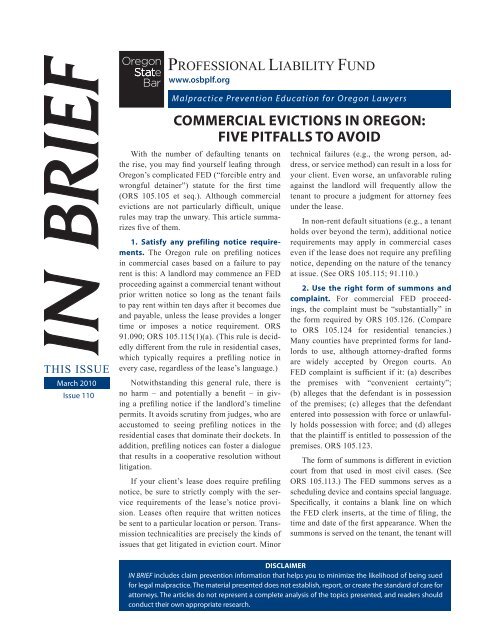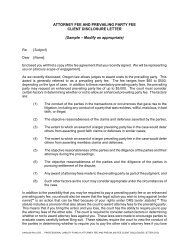commercial evictions in oregon - Professional Liability Fund
commercial evictions in oregon - Professional Liability Fund
commercial evictions in oregon - Professional Liability Fund
You also want an ePaper? Increase the reach of your titles
YUMPU automatically turns print PDFs into web optimized ePapers that Google loves.
PROFESSIONAL LIABILITY FUNDwww.osbplf.orgM a l p ra c t i ce Prevention Educa t i o n f o r O r e g o n L a w y e r sTHIS ISSUEMarch 2010Issue 110COMMERCIAL EVICTIONS IN OREGON:FIVE PITFALLS TO AVOIDWith the number of default<strong>in</strong>g tenants onthe rise, you may f<strong>in</strong>d yourself leaf<strong>in</strong>g throughOregon’s complicated FED (“forcible entry andwrongful deta<strong>in</strong>er”) statute for the first time(ORS 105.105 et seq.). Although <strong>commercial</strong><strong>evictions</strong> are not particularly difficult, uniquerules may trap the unwary. This article summarizesfive of them.1. Satisfy any prefil<strong>in</strong>g notice requirements.The Oregon rule on prefil<strong>in</strong>g notices<strong>in</strong> <strong>commercial</strong> cases based on a failure to payrent is this: A landlord may commence an FEDproceed<strong>in</strong>g aga<strong>in</strong>st a <strong>commercial</strong> tenant withoutprior written notice so long as the tenant failsto pay rent with<strong>in</strong> ten days after it becomes dueand payable, unless the lease provides a longertime or imposes a notice requirement. ORS91.090; ORS 105.115(1)(a). (This rule is decidedlydifferent from the rule <strong>in</strong> residential cases,which typically requires a prefil<strong>in</strong>g notice <strong>in</strong>every case, regardless of the lease’s language.)Notwithstand<strong>in</strong>g this general rule, there isno harm – and potentially a benefit – <strong>in</strong> giv<strong>in</strong>ga prefil<strong>in</strong>g notice if the landlord’s timel<strong>in</strong>epermits. It avoids scrut<strong>in</strong>y from judges, who areaccustomed to see<strong>in</strong>g prefil<strong>in</strong>g notices <strong>in</strong> theresidential cases that dom<strong>in</strong>ate their dockets. Inaddition, prefil<strong>in</strong>g notices can foster a dialoguethat results <strong>in</strong> a cooperative resolution withoutlitigation.If your client’s lease does require prefil<strong>in</strong>gnotice, be sure to strictly comply with the servicerequirements of the lease’s notice provision.Leases often require that written noticesbe sent to a particular location or person. Transmissiontechnicalities are precisely the k<strong>in</strong>ds ofissues that get litigated <strong>in</strong> eviction court. M<strong>in</strong>ortechnical failures (e.g., the wrong person, address,or service method) can result <strong>in</strong> a loss foryour client. Even worse, an unfavorable rul<strong>in</strong>gaga<strong>in</strong>st the landlord will frequently allow thetenant to procure a judgment for attorney feesunder the lease.In non-rent default situations (e.g., a tenantholds over beyond the term), additional noticerequirements may apply <strong>in</strong> <strong>commercial</strong> caseseven if the lease does not require any prefil<strong>in</strong>gnotice, depend<strong>in</strong>g on the nature of the tenancyat issue. (See ORS 105.115; 91.110.)2. Use the right form of summons andcompla<strong>in</strong>t. For <strong>commercial</strong> FED proceed<strong>in</strong>gs,the compla<strong>in</strong>t must be “substantially” <strong>in</strong>the form required by ORS 105.126. (Compareto ORS 105.124 for residential tenancies.)Many counties have prepr<strong>in</strong>ted forms for landlordsto use, although attorney-drafted formsare widely accepted by Oregon courts. AnFED compla<strong>in</strong>t is sufficient if it: (a) describesthe premises with “convenient certa<strong>in</strong>ty”;(b) alleges that the defendant is <strong>in</strong> possessionof the premises; (c) alleges that the defendantentered <strong>in</strong>to possession with force or unlawfullyholds possession with force; and (d) allegesthat the pla<strong>in</strong>tiff is entitled to possession of thepremises. ORS 105.123.The form of summons is different <strong>in</strong> evictioncourt from that used <strong>in</strong> most civil cases. (SeeORS 105.113.) The FED summons serves as aschedul<strong>in</strong>g device and conta<strong>in</strong>s special language.Specifically, it conta<strong>in</strong>s a blank l<strong>in</strong>e on whichthe FED clerk <strong>in</strong>serts, at the time of fil<strong>in</strong>g, thetime and date of the first appearance. When thesummons is served on the tenant, the tenant willDISCLAIMERIN BRIEF <strong>in</strong>cludes claim prevention <strong>in</strong>formation that helps you to m<strong>in</strong>imize the likelihood of be<strong>in</strong>g suedfor legal malpractice. The material presented does not establish, report, or create the standard of care forattorneys. The articles do not represent a complete analysis of the topics presented, and readers shouldconduct their own appropriate research.
know when to come to court. The summons also conta<strong>in</strong>swarn<strong>in</strong>gs and <strong>in</strong>structions to the tenant that are unique toeviction court. If you use the wrong summons, your actionmay never get scheduled and may be subject to dismissal.3. Properly serve the summons and compla<strong>in</strong>t. Afterwait<strong>in</strong>g out any applicable notice period and confirm<strong>in</strong>gthat the tenant has not cured the default, the landlordmay file its FED compla<strong>in</strong>t. If you are not us<strong>in</strong>g a localform with built-<strong>in</strong> carbon copies, file the orig<strong>in</strong>al summonsand compla<strong>in</strong>t with additional copies per ORS 105.135.The clerk will then mail one copy to the tenant(s) per ORS105.135(3)(a). The landlord’s fil<strong>in</strong>g fee <strong>in</strong> MultnomahCounty is $197 (plus additional fees if there are multipledefendants). Additional fees may be required from thelandlord depend<strong>in</strong>g on where the case goes after fil<strong>in</strong>g.Consider call<strong>in</strong>g the FED clerk to verify the proper fee.The Multnomah County Sheriff will serve the landlord’ssummons and compla<strong>in</strong>t for $36. (Higher fees mayapply to serve multiple defendants, and private processservers may be used.) By statute, the service must occurby the end of the next judicial day for your action to beeffective. (ORS 105.135(3)(b).)The court will also mail acopy of the summons and compla<strong>in</strong>t to the property specified<strong>in</strong> the summons, as required by ORS 105.135(3)(a).Consider us<strong>in</strong>g a private process server rather than thesheriff. If you go this route, be sure that the process serverknows the special service requirements for FED proceed<strong>in</strong>gs(ORS 105.135). In general, those requirements contemplatepersonal service on the tenant; if the defendant isnot “available for service,” service may be accomplished“by attach<strong>in</strong>g a true copy of the summons and compla<strong>in</strong>t<strong>in</strong> a secure manner to the ma<strong>in</strong> entrance to that portion ofthe premises of which the defendant has possession.” ORS105.135(3)(b).Problems can arise when the tenant has separate mail<strong>in</strong>gand physical addresses. If the FED service method ispost<strong>in</strong>g, it must be accomplished at the leased premises.Service by post<strong>in</strong>g at the tenant’s registered agent’s officeis <strong>in</strong>sufficient if it is a place other than the leased premises.To avoid debate, consider serv<strong>in</strong>g at both locations.Tell your process server to execute and return the proofof service to you as soon as possible. File your orig<strong>in</strong>alproof of service with the court as soon as possible, as requiredby ORS 105.135(5). Also consider br<strong>in</strong>g<strong>in</strong>g a copyof your proof of service to any hear<strong>in</strong>g, as the orig<strong>in</strong>alproof of service may not have reached the court’s file bythe time the clerk assembles the files for the first appearance.(The court is deal<strong>in</strong>g with these cases by the dozensand may not have all your paperwork <strong>in</strong> order.) In MultnomahCounty you must also file a completed declarationthat the defendant is not <strong>in</strong> the military, a m<strong>in</strong>or, or <strong>in</strong>capacitated.This declaration may not be required if thedefendant is a corporation or an LLC.4. Understand the three-step process. The first stepis the first appearance, which comb<strong>in</strong>es report<strong>in</strong>g the statusof the case and mediation. The parties show up at a “cattlecall” hear<strong>in</strong>g, and the judge or a clerk tells all the parties <strong>in</strong>the room to try to work th<strong>in</strong>gs out. If one party to an FEDaction doesn’t show up, the other side w<strong>in</strong>s. If you resolveyour dispute, you pen a deal and the case may be conditionallydismissed. If the tenant then fails to perform as agreed,the landlord can obta<strong>in</strong> a “push-button” eviction by fil<strong>in</strong>g adeclaration of noncompliance. If you can’t work th<strong>in</strong>gs out,a trial is scheduled for a later date (generally 7 to 15 days).The trial is the second step, and either party can request ajury. The third step, assum<strong>in</strong>g the landlord procures a judgmentof restitution, <strong>in</strong>volves enforcement of the judgment:the landlord is entitled to a notice of restitution (which givesthe tenant four days to move out of the premises) and a writof execution (which <strong>in</strong>structs the sheriff to assist the landlordwith removal of the tenant). (See generally, ORS 105.153;ORS 105.156.) The landlord may also be entitled to a judgmentfor attorney fees based on contractual lease provisionsand ORCP 68.5. File <strong>in</strong> the right county! Don’t rely on a “Portland”or “Lake Oswego” address – county l<strong>in</strong>es don’t alwaysmatch up with common assumptions. Talk with the client andcheck a map. If you file <strong>in</strong> the wrong county, your case will(or should) be dismissed. See ORS 105.110; ORS 14.040(5).For a more detailed discussion of <strong>commercial</strong> evictionprocedures, consult Real Estate Disputes (Oregon CLE1993 & Supp 2002). Readers are also welcome to contactthe author for free CLE materials on this topic.Erick J. HayniePerk<strong>in</strong>s Coie LLPThanks to Jeffrey S. Bennett for his assistance with this article.March 2010– Page 2www.osbplf.org
















